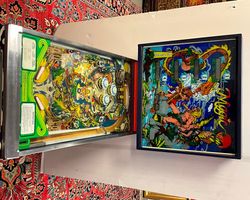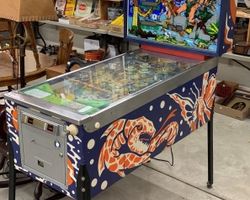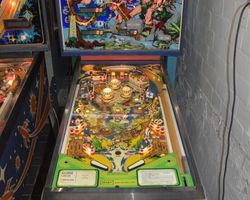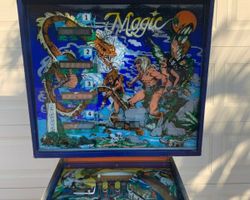Magic
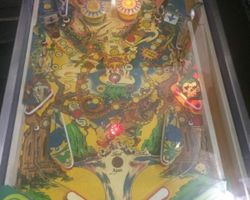
Average Prices: USD $400 to $1,600
Produced: August, 1979
Production Run: 2,202 units
Machine Type: Solid State Electronic
MPU: Stern M-100 MPU
Players: 4
Design by: Mike Kubin
Art by: Bob Timm
The pinball machine "Magic" emerged from the production lines of Stern Electronics, Incorporated in August 1979, presenting a captivating fantasy theme to the public. This solid-state electronic (SS) machine was conceived during a period of transition and innovation within the pinball industry, as manufacturers moved decisively from electro-mechanical designs to more advanced digital systems. Stern, a prominent name in pinball, aimed to deliver a game that combined engaging play with a thematic aesthetic that would resonate with players.
The design of "Magic" was primarily led by Mike Kubin, who charted the course for its gameplay mechanics and playfield layout. The visual identity of the machine was crafted by Bob Timm, an artist known for his contributions to pinball backglasses and playfields. Timm personally confirmed his involvement in both the backglass and playfield artwork, noting that cabinet art was typically handled by the cabinet manufacturers themselves. The fantasy theme, reminiscent of heroic sagas and mystical realms, was brought to life through Timm’s vibrant, colorful palette, creating an inviting visual experience. "Magic" had a production run of 2,466 units, comprising 2,202 full games and 264 knock-down games, making it a substantial release for Stern Electronics during its operational lifespan from early August to late September 1979. This machine utilized the Stern M-100 MPU, a reliable platform for the era's solid-state games.
Signature Features and Design
"Magic" distinguishes itself with a collection of classic pinball features, meticulously integrated to enhance both gameplay and visual appeal. The machine incorporates two flippers for precise ball control, supported by three powerful pop bumpers that contribute to the game's brisk pace. Two slingshots protect the outlanes, providing dynamic rebounds that test player reflexes. The playfield is populated with various targets that are central to scoring and progression: four standup targets and four star rollovers reward accurate shots, while two spinning targets offer rapid point accumulation when struck repeatedly. A bank of three drop targets presents a clear objective, and a kick-out hole acts as a collection point or a trigger for specific game states.
A notable design element lies in the artwork itself. The fantasy theme is consistently applied across the backglass and playfield, featuring a mystical wizard and mythical creatures that immerse players in its world. The colors are bright and contribute to a vibrant atmosphere, which was a strong point for a machine of its vintage. A subtle yet distinct detail that enhances the machine’s character is the design of the pop bumper caps, which sometimes feature a "Skully" or "Dracula"-themed motif, adding a touch of thematic flair that players often appreciate. These features, from the mechanical components to the artistic embellishments, coalesce to create a cohesive and engaging pinball experience.
Playfield and Mechanics
The playfield of "Magic" is laid out to encourage quick, direct play, yet it harbors elements that demand precision. It is often described as open and fast, providing clear shot lines to various objectives. Central to the playfield are the three pop bumpers, strategically positioned to create chaotic yet rewarding ball movement in the upper region. Below these, the main action unfolds, centered around the 3-bank drop targets. These targets are a primary scoring objective, lighting up for significant points upon completion. To the sides, four standup targets and two spinning targets offer additional opportunities for scoring and building bonus.
The two main orbits, running along the sides of the playfield, are satisfying to shoot, allowing for fast ball travel and setup for subsequent shots. A kick-out hole typically functions as a reward saucer, collecting the ball after specific conditions are met, often leading to bonus awards or the initiation of special features. The art on the playfield, characterized by its bright colors and detailed fantasy elements, complements the mechanical layout, guiding the player's eye to key areas. While some players note a relatively open space in the middle of the playfield, this contributes to the machine's overall speed, minimizing dead time. The geometry of the playfield often leads to energetic ricochets, demanding quick reactions and ball control. The area between the flippers and the outlanes presents a challenging "canyon-like" space, making ball recovery a critical skill to master.
Gameplay Dynamics
"Magic" offers gameplay mechanics that blend straightforward objectives with an engaging progression system, keeping players invested in each session. The core objective revolves around spelling the word "M-A-G-I-C." This is achieved by hitting specific targets or completing certain sequences on the playfield. Successfully spelling "M-A-G-I-C" lights the "Special" feature, which can award extra balls or free games, providing a rewarding sense of accomplishment and a tangible goal beyond pure score accumulation.
Beyond spelling the word, the 3-bank drop targets are central to achieving high scores. Systematically knocking down these targets multiple times is the most effective path to significant point totals. The two spinning targets, when activated, offer rapid-fire scoring as the ball repeatedly strikes them, encouraging players to aim for and maintain control around these high-value zones. The game is frequently described as fast-paced and addictive; while relatively easy to grasp its fundamental rules, "Magic" also presents a humbling challenge to master. The absence of ball saves, typical for machines of this era, means that every plunge and every shot carries weight, demanding precision and a keen understanding of the playfield's angles. The collect bonus saucer, while rewarding, sometimes relies more on fortunate bounces than precise skill shots, adding an element of unpredictability to the game's flow. This blend of accessible objectives and challenging execution ensures that "Magic" provides a rewarding experience for both casual players and those seeking to refine their pinball skills.
Reception and Legacy
"Magic" by Stern Electronics generally elicits a positive reception within the pinball community, often being regarded as an underrated machine from its era. Players frequently commend its enjoyable, fast, and engaging gameplay, noting its addictive quality that encourages repeat plays. Its strengths lie in its core playability: the satisfaction derived from spelling "M-A-G-I-C" and consistently dropping the bank of targets contributes significantly to its appeal. The swift action generated by the pop bumpers and the satisfying orbits are also frequently cited as positive aspects. Furthermore, for collectors and operators, "Magic" is recognized for its relative ease of maintenance and its consistent reliability, which are practical advantages for an older solid-state machine.
However, "Magic" is not without its critical points. The sound package, while standard for 1979 solid-state games, is often described as basic, relying on simple blips and bleeps rather than more complex melodies or effects. Some aspects of the artwork, particularly the side cabinet art, are occasionally deemed less cohesive with the overall fantasy theme or appear dated when compared to its vibrant playfield and backglass. The playfield layout, while generally fast, has been noted for having an open central area that some feel could have been utilized more creatively. Additionally, the game's challenging angles and the lack of ball saves can lead to quick games, a point of frustration for some players. Despite these criticisms, "Magic" holds a respectable place among early Stern solid-state offerings. Its enduring appeal stems from its straightforward yet challenging gameplay, demonstrating how a well-designed rule set and engaging playfield mechanics can create a lasting impression, influencing the fundamental design principles of subsequent Stern machines and retaining its status as a machine that offers substantial entertainment value.
Sponsored Links
 Ebay Listings
Ebay Listings
 Auction Results
Auction Results
| Cost | Location | Date |
|---|---|---|
| USD $650 |  Maryland, United States Maryland, United States |
15 May, 2025 |
| EUR €2,500 |  Nordrhein-Westfalen, Germany Nordrhein-Westfalen, Germany |
08 October, 2024 |
| USD $2,400 |  Florida, United States Florida, United States |
02 March, 2024 |
| USD $1,000 |  Maryland, United States Maryland, United States |
26 February, 2024 |
| USD $1,463 |  Maryland, United States Maryland, United States |
17 January, 2024 |
| USD $260 |  Pennsylvania, United States Pennsylvania, United States |
09 August, 2023 |
| USD $1,700 |  Oregon, United States Oregon, United States |
28 April, 2023 |
| USD $1,700 |  Pennsylvania, United States Pennsylvania, United States |
19 November, 2022 |
| AUD $2,499 |  Western Australia, Australia Western Australia, Australia |
02 September, 2020 |
| AUD $2,999 |  Western Australia, Australia Western Australia, Australia |
24 August, 2020 |


Private Policy · Search Website · Contact Us
As an eBay Partner, we may earn a commission from qualifying purchases made through links on this site, at no additional cost to you.
All trademarks and copyrighted materials remain property of their respective owners. All other content copyright 2007 - 2025 Pinpedia.

